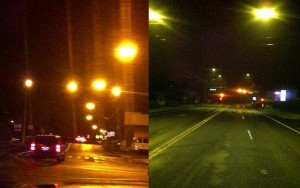Shift to High-Tech Streetlights Saves Dark Skies, Money
In a move applauded by astronomers – and one that will no doubt be appreciated by taxpayers – Hawai`i County is replacing its streetlights with more modern versions.
The Department of Public Works is installing lamps that use light-emitting diodes, also known as LEDs, to replace the existing low-pressure sodium fixtures.
Although they produce less light, the LED fixtures are more “directional,” said Richard Wainscoat, a professor at the University of Hawai`i’s Institute for Astronomy.
“The new streetlights direct light on the roadway,” he said. “There’s much less wasted light.”
They also use less than half of the electricity required for the low-pressure sodium fixtures.
Artificial light in the sky is the bane of astronomers because it makes it more difficult to see faint objects.
And light pollution has long been a concern on the Big Island as some of the world’s best telescopes are located atop Mauna Kea. That’s why Hawai`i County was one of the first locations in the nation to enact a law restricting the types and uses of lighting fixtures.
The county ordinance on outdoor lighting was first passed in 1988 and mandated the use of the low-pressure sodium streetlights. It was amended last year to require fully shielded lighting fixtures and also to allow LED fixtures within a quarter-mile of traffic signals and 100 feet of marked crosswalks.

The low-pressure sodium streetlights are shown on the left, while the new LED versions are on the right. Photos courtesy of Hawai`i County.
That means the law will have to be amended further to allow for replacement of all of the county’s streetlights.
The county used $500,000 in federal stimulus funds to purchase 1,000 of the LED lights. This past summer, 90 of the streetlights were installed in Waimea, and work is ongoing to change 20 more along Kinoole Street from Waianuenue Avenue to Haihai Street in Hilo.
The old-style low-pressure sodium streetlights cast an amber glow that astronomers could filter out, although they also made it difficult to tell them apart from the yellow caution light on traffic signals.
Because the LED lights being installed are equipped to filter out blue light, they are in keeping with last year’s amendment and also better for astronomy than unfiltered versions. The minus-blue filter gives the lights a yellow-green hue.
“The big picture is, the LED lights are friendlier to astronomy,” said Wainscoat, who is the chairman of the Light Pollution Working Group of the International Astronomical Union. He provided testimony last year before the County Council in favor of the changes to the law.
“A dark night sky is a fundamental requirement for astronomical research,” he told council members.
Keeping the night sky dark is also the focus of a bill passed during the past session of the state Legislature.
Act 287 requires that beginning July 1, 2014, all new outdoor light fixtures installed by state agencies be fully shielded or directed to minimize upward glow.
Like Hawai`i County’s ordinance, the state law contains exemptions for emergency or temporary lighting, low-power lights and those used for sporting or other events that are turned off by 11 p.m.
The bill’s sponsor, Sen. Will Espero of Oahu, said during the 2011 session lawmakers passed a more stringent bill, but that was vetoed by the governor because it included the private sector.
Espero said expansion of the law is likely as light technology improves.
“I think it’s a good start,” he said.
***Updated Aug. 29 to correct information about the amount of light emitted by LEDs and the impact of outdoor lighting on astronomy.***













